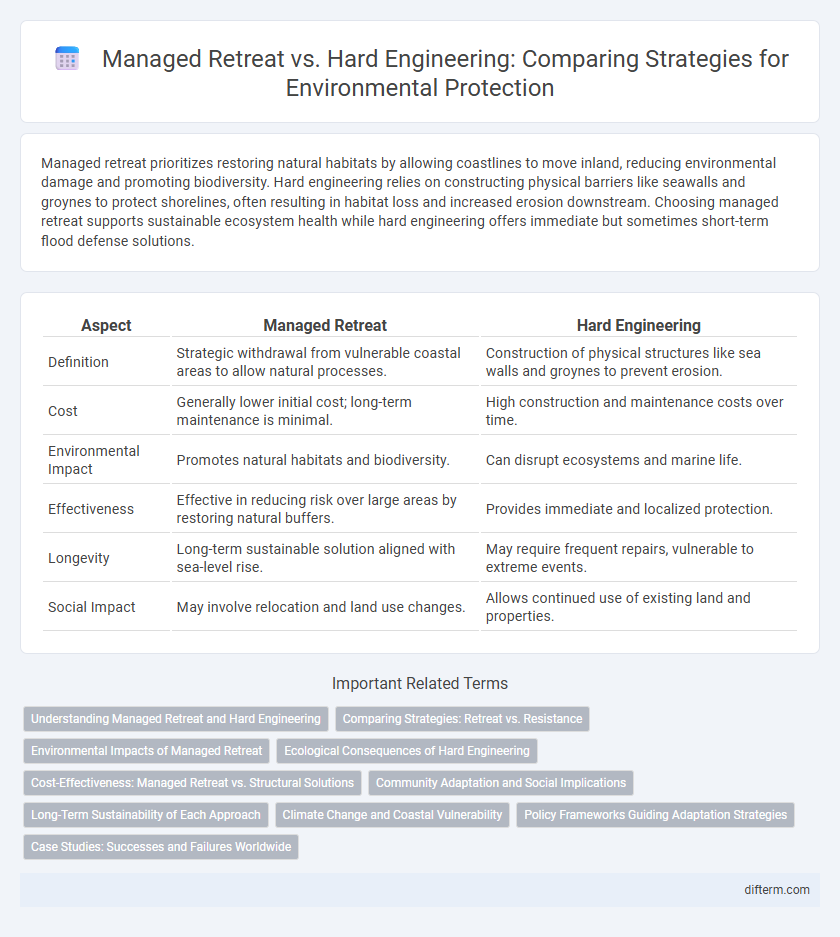Managed retreat prioritizes restoring natural habitats by allowing coastlines to move inland, reducing environmental damage and promoting biodiversity. Hard engineering relies on constructing physical barriers like seawalls and groynes to protect shorelines, often resulting in habitat loss and increased erosion downstream. Choosing managed retreat supports sustainable ecosystem health while hard engineering offers immediate but sometimes short-term flood defense solutions.
Table of Comparison
| Aspect | Managed Retreat | Hard Engineering |
|---|---|---|
| Definition | Strategic withdrawal from vulnerable coastal areas to allow natural processes. | Construction of physical structures like sea walls and groynes to prevent erosion. |
| Cost | Generally lower initial cost; long-term maintenance is minimal. | High construction and maintenance costs over time. |
| Environmental Impact | Promotes natural habitats and biodiversity. | Can disrupt ecosystems and marine life. |
| Effectiveness | Effective in reducing risk over large areas by restoring natural buffers. | Provides immediate and localized protection. |
| Longevity | Long-term sustainable solution aligned with sea-level rise. | May require frequent repairs, vulnerable to extreme events. |
| Social Impact | May involve relocation and land use changes. | Allows continued use of existing land and properties. |
Understanding Managed Retreat and Hard Engineering
Managed retreat involves the strategic withdrawal from vulnerable coastal areas to allow natural processes to occur, reducing long-term environmental damage and financial costs associated with flood defenses. Hard engineering methods, such as seawalls, groynes, and revetments, provide immediate protection by physically blocking or redirecting water but can lead to increased erosion downstream and habitat loss. Understanding the balance between these approaches is crucial for sustainable coastal management that addresses both ecological preservation and community safety.
Comparing Strategies: Retreat vs. Resistance
Managed retreat prioritizes relocating communities and ecosystems away from vulnerable coastlines to restore natural buffers and reduce long-term costs. In contrast, hard engineering employs physical structures like seawalls and groynes to resist erosion and flooding but often leads to habitat disruption and expensive maintenance. Evaluating these strategies requires balancing ecological resilience, economic feasibility, and social impacts to achieve sustainable coastal management.
Environmental Impacts of Managed Retreat
Managed retreat reduces long-term environmental damage by allowing natural processes to restore coastal habitats such as wetlands and salt marshes, enhancing biodiversity and carbon sequestration. Unlike hard engineering structures like seawalls, which often cause habitat loss and disrupt sediment flow, managed retreat fosters ecosystem resilience and mitigates erosion sustainably. This approach also increases natural floodplains, improving water filtration and providing critical buffer zones against storm surges.
Ecological Consequences of Hard Engineering
Hard engineering techniques such as seawalls, groynes, and revetments often lead to significant ecological consequences including habitat loss, reduced biodiversity, and disruption of natural coastal processes. These structures can cause erosion downstream, negatively impacting intertidal zones and marine ecosystems essential for fish and bird species. Managed retreat offers a more sustainable alternative by restoring natural habitats and allowing ecosystems to adapt to changing environmental conditions.
Cost-Effectiveness: Managed Retreat vs. Structural Solutions
Managed retreat offers a cost-effective alternative to hard engineering by minimizing long-term maintenance expenses and allowing natural processes to reduce flood risk. Structural solutions such as seawalls and groynes require significant upfront investment and ongoing repair costs, which can strain local government budgets. Economic analyses often reveal managed retreat as a sustainable strategy with lower financial burdens and enhanced environmental benefits over time.
Community Adaptation and Social Implications
Managed retreat prioritizes long-term community adaptation by relocating populations away from high-risk coastal areas, reducing vulnerability to climate change impacts and fostering sustainable land use. Hard engineering methods such as seawalls and groynes offer immediate protection but often lead to social challenges, including displacement, loss of livelihoods, and altered community dynamics. The social implications of managed retreat involve complex decisions around cultural heritage preservation and equitable resource distribution, making community engagement essential for successful adaptation strategies.
Long-Term Sustainability of Each Approach
Managed retreat enhances long-term sustainability by allowing natural ecosystems to adapt and absorb environmental changes, reducing maintenance costs and ecological damage. Hard engineering structures such as sea walls provide immediate protection but often lead to increased erosion downstream and substantial upkeep expenses over time. Prioritizing managed retreat aligns with climate resilience goals by promoting habitat restoration and minimizing human intervention in vulnerable coastal zones.
Climate Change and Coastal Vulnerability
Managed retreat offers a sustainable response to rising sea levels by allowing natural coastal processes to occur, reducing long-term risk and habitat loss caused by climate change. Hard engineering solutions such as seawalls and groynes provide immediate protection against erosion and storm surges but often disrupt sediment flow and increase vulnerability downstream. Coastal vulnerability assessments highlight that integrating managed retreat with targeted hard engineering can optimize resilience against intensifying climate impacts.
Policy Frameworks Guiding Adaptation Strategies
Policy frameworks guiding adaptation strategies prioritize managed retreat as a long-term, sustainable response to coastal erosion and flooding, emphasizing ecosystem restoration and community relocation while incorporating climate change projections and risk assessments. In contrast, hard engineering approaches such as seawalls and groynes are often regulated by policies that focus on immediate protection but face challenges related to environmental degradation, high maintenance costs, and limited adaptability to rising sea levels. Effective adaptation policies advocate for integrated coastal zone management, combining managed retreat with selective hard engineering to balance human safety, ecological integrity, and socio-economic impacts.
Case Studies: Successes and Failures Worldwide
Managed retreat in coastal areas like the Netherlands and Louisiana demonstrates long-term sustainability by allowing natural floodplains to absorb storm surges, reducing property damage and ecosystem disruption. Hard engineering solutions, such as seawalls in Japan and the UK, provide immediate protection but often lead to increased erosion and high maintenance costs over time. Case studies reveal that integrated approaches combining managed retreat and hard engineering yield more resilient and cost-effective outcomes for climate adaptation.
Managed retreat vs Hard engineering Infographic

 difterm.com
difterm.com